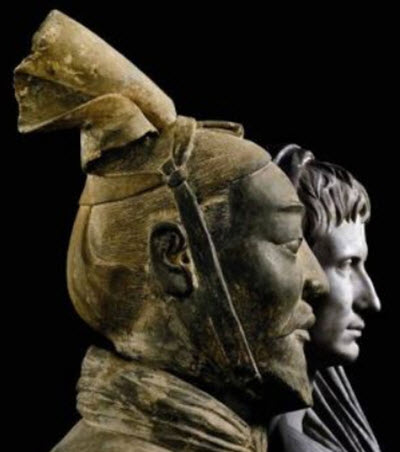The Ancient Romans loved Chinese silk textiles, but for a long time knew very little of both China and silk production. For instance, several old Roman sources claim that silk grows on trees, which is sort of true and not true at all at the same time, since silk cloth is woven from silk harvested from the cocoons created by silkworms, the larva of the species Bombyx mori (Domestic silkmoth). These larva do live in trees, preferably the White mulberry tree.
 The silk arrived to Ancient Rome already spun and woven, transported through Asia along the Silk Road. Typically, no individual merchant that made the whole arduous journey all the way from China to Rome. Instead, the silk was bought and sold multiple times along the way, changing ownership over and over again before it finally reached its ultimate user. This also meant that many people active in the silk trade were families only with their own section of the Silk Road, plus whatever they had managed to puzzle together by chatting with other merchants they met in the trading hubs.
The silk arrived to Ancient Rome already spun and woven, transported through Asia along the Silk Road. Typically, no individual merchant that made the whole arduous journey all the way from China to Rome. Instead, the silk was bought and sold multiple times along the way, changing ownership over and over again before it finally reached its ultimate user. This also meant that many people active in the silk trade were families only with their own section of the Silk Road, plus whatever they had managed to puzzle together by chatting with other merchants they met in the trading hubs.
First attempt
On their end of the Silk Road, the Chinese knew very little of Rome or the rest of Europe, but in the first century, during the Han dynasty, General Pan Chao decided to sent an ambassador to Rome – or rather to Da Chi’en as the Chinese called the Roman Empire. This was after he and his soldiers had successfully purged the Tarim Basin of the Xiongnu who were causing trouble for the Chinese along this section of the Silk Road.
So, in the year 97, the Chinese ambassador Kan Ying commenced on a journey along the Silk Road, heading for that rich and evidently silk-loving empire far away in the mysterious West. With him, be brought exclusive gifts for the Roman rulers.
After reaching Mesopotamia, Kan Ying’s plan was to sail the rest of the way to Europe, but he was told by local sailors that the journey could take up to two years. Hearing this, he gave up and went back to China. Kan Ying was probably deliberately fed incorrect information about the sea voyage by the Parthians, who didn’t want China to be in direct contact with Rome as that might have a negative impact on Parthian profits from the lucrative silk trade.
First successful attempt
In the year 166, an envoy dispatched by Roman Emperor Marcus Aurelius successfully traveled from the Persian Gulf to China, thus establishing the first direct contact between the two empires. This was after the Romans had defeated Parthia on the battlef(Bombyx mori) ield, taking control over the Persian Gulf themselves.